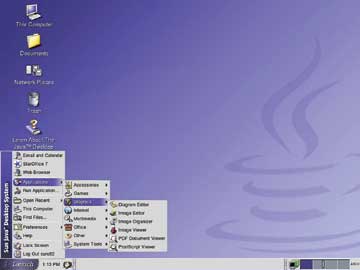Sun Java Desktop System Lets You Focus on What's Important
 Every dollar schools and universities spend on expensive, proprietary software
is a dollar less spent on education. So it is really no surprise that schools
and universities worldwide have embraced open source software technologies—one
of the most popular of which is Linux. The problem is that until recently, Linux
was only available in server environments; even if education centers had a Linux
server, they would still have to invest in proprietary platforms for desktop
solutions. All this has changed, and schools and universities now have access
to a full, open source computing environment.
Every dollar schools and universities spend on expensive, proprietary software
is a dollar less spent on education. So it is really no surprise that schools
and universities worldwide have embraced open source software technologies—one
of the most popular of which is Linux. The problem is that until recently, Linux
was only available in server environments; even if education centers had a Linux
server, they would still have to invest in proprietary platforms for desktop
solutions. All this has changed, and schools and universities now have access
to a full, open source computing environment.
Open source technologies are free, but often need to be compiled in a coherent
fashion from a single source to provide product support. Sun Microsystems and
others are leveraging these technologies in an attempt to offer an alternative
to the expensive, insecure Microsoft Windows platform with products like the
Java Desktop System, a Linux and Solaris-based desktop package based on open
standards and leading open source components. The system includes the GNOME
desktop environment, StarOffice productivity suite, Mozilla browser, Evolution
mail and calendar client, and Java 2 Platform Standard Edition.
Cost Savings
As a complete package, the Java Desktop System offers educators substantial
cost savings over Microsoft Windows and Microsoft Office. In fact, the Java
Desktop System costs up to 80 percent less than a typical Microsoft Windows
environment, with even greater cost savings through educational discounts. Furthermore,
the Java Desktop System’s low hardware requirements allow educational
institutions to extend their investment in current hardware, saving money on
new PC purchases.
Consider this: replacing 1,000 desktops at $1,000 each costs a staggering $1
million—a sum sure to cause cash-strapped school districts to take a second
look at their priorities.
Security
But the benefits go far beyond budgeted costs. Computer Economics estimates
that 2003 saw 7,064 new viruses, worms and Trojan horses, costing the private
sector more than $13 billion. In the educational sector, potential losses go
beyond the damage to costly school systems by threatening the integrity of the
intellectual property stored there. Fortunately, Linux desktops like the Java
Desktop System offer superior built-in security features that prevent viruses,
worms and unauthorized users from modifying system files without root-level
access.
Robust security is critical since educational institutions house priceless
research, private academic records and other sensitive data on their desktop
systems. More specific to the Java Desktop System, Sun’s software provides
additional security by supporting single sign-on technology through Java Cards
and the Sun Java Identity Server, and by offering two-factor authentication
and advanced identity management capabilities.
Usability and Familiarity
Many people fear that transitioning to a Linux desktop is too difficult—some
early Linux desktop distributions could not even cut and paste text between
applications. In contrast, today’s Linux desktops are polished platforms
containing tightly integrated applications that go beyond all the basic drag-and-drop,
copy/paste and other functionality expected from desktop software.
Years of engineering work went into making the Java Desktop System look and
behave similarly to Microsoft Windows so users find it easier to migrate. For
example, both the Java Desktop System and Microsoft Windows have a “Documents”
default folder and where Windows has a “Start” button the Java Desktop
System has a similar “Launch” button. The StarOffice productivity
suite included in the Java Desktop System helps cut complexity in migration
even more by providing nearly flawless interoperability with Microsoft Office
file formats.
Sun Microsystems went even further to drive complexity out of the equation
for IT administrators as well by including the industry’s first built-in
desktop configuration management software for Linux desktops.
Change is Good
Educational institutions often lead change and the move to Linux is no exception.
Sun is currently working with the People’s Republic of China to bridge
the digital divide by building a Linux desktop based on the Java Desktop System
for deployment to 200 million users from educational institutions, the public
sector to private users.
StarOffice and OpenOffice.org, key components of the Java Desktop System with
over 40 million downloads worldwide, have seen unmitigated success among academic
institutions having been formally adopted by schools in the Canadian state of
Ontario, the state government of Haryana, India, and numerous other government
institutions. Sun’s Java Desktop System interface, solid security, and
extensive features, is an ideal place to start.
To learn more about Sun’s Java Desktop System, visit http://www.sun.com/javadesktopsystem